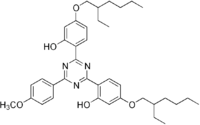Bemotrizinol
 | |
| Names | |
|---|---|
| IUPAC name
2,2′-[6-(4-methoxyphenyl)- 1,3,5-triazine-2,4-diyl] bis{5-[(2-ethylhexyl)oxy]phenol} | |
| Other names
Tinosorb S Bis-ethylhexyloxyphenol methoxyphenyl triazine Anisotriazine | |
| Identifiers | |
| 187393-00-6 | |
| 3D model (Jmol) | Interactive image |
| Abbreviations | BEMT |
| ChEMBL | ChEMBL2104956 |
| ChemSpider | 10645286 |
| ECHA InfoCard | 100.109.468 |
| UNII | PWZ1720CBH |
| |
| |
| Properties | |
| C38H49N3O5 | |
| Molar mass | 627.81 g/mol |
| Except where otherwise noted, data are given for materials in their standard state (at 25 °C [77 °F], 100 kPa). | |
| | |
| Infobox references | |
Bemotrizinol (INN[1][2]/USAN,[3] INCI bis-ethylhexyloxyphenol methoxyphenyl triazine) is an oil-soluble organic compound that is added to sunscreens to absorb UV rays. It is marketed as Tinosorb S by BASF and as Escalol S by Ashland Inc. A recent development is Tinosorb S Aqua, which is bemotrizinol in a PMMA matrix dispersed in water. This makes it possible to add bemotrizinol to the water phase.[4]
Bemotrizinol is a broad-spectrum UV absorber, absorbing UVB as well as UVA rays. It has two absorption peaks, 310 and 340 nm.[5] It is highly photostable. Even after 50 MEDs (minimal erythemal doses), 98.4% remains intact. It helps prevent the photodegradation of other sunscreen actives like avobenzone.[6]
Bemotrizinol has strong synergistic effects on the SPF when formulated with bisoctrizole, ethylhexyl triazone or iscotrizinol.[7] It is the most effective UV absorber available measured by SPF, based on the maximum concentration permitted by European legislation.[8]
Bemotrizinol is not approved by the United States Food and Drug Administration, but is approved in the European Union since the year 2000[9] and other parts of the world, including Australia.[10][11]
Unlike some other organic sunscreen actives, it shows no estrogenic effects in vitro.[12]
References
- ↑ http://whqlibdoc.who.int/druginfo/18_4_2004_INN92.pdf
- ↑ http://whqlibdoc.who.int/druginfo/INN_2005_list54.pdf
- ↑ http://www.ama-assn.org/ama1/pub/upload/mm/365/bemotrizinol.doc
- ↑ Tinosorb S Aqua info
- ↑ Vielhaber G, Grether-Beck S, Koch O, Johncock W, Krutmann J (March 2006). "Sunscreens with an absorption maximum of > or =360 nm provide optimal protection against UVA1-induced expression of matrix metalloproteinase-1, interleukin-1, and interleukin-6 in human dermal fibroblasts". Photochem Photobiol Sci. 5 (3): 275–82. doi:10.1039/b516702g. PMID 16520862.
- ↑ Chatelain E, Gabard B (September 2001). "Photostabilization of Butyl methoxydibenzoylmethane (Avobenzone) and Ethylhexyl methoxycinnamate by Bis-ethylhexyloxyphenol methoxyphenyl triazine (Tinosorb S), a new UV broadband filter". Photochem Photobiol. 74 (3): 401–6. doi:10.1562/0031-8655(2001)074<0401:POBMAA>2.0.CO;2. PMID 11594052.
- ↑ http://www.ciba.com/tinosorb-s_brochure.pdf
- ↑ Couteau C, Pommier M, Paparis E, Coiffard LJ (June 2007). "Study of the efficacy of 18 sun filters authorized in European Union tested in vitro". Pharmazie. 62 (6): 449–52. PMID 17663193.
- ↑ .SpringerLink - Journal Article
- ↑ NEW-WAVE SUNSCREENS: Active ingredient makers are frustrated by the long list of sunscreens and UV-A testing protocols that are still awaiting FDA decisions, Chemical & Engineering News, April 11, 2005, Volume 83, Number 15, pp. 18–22. Online version
- ↑ Australian Regulatory Guidelines for OTC Medicines - Chapter 10
- ↑ Ashby J, Tinwell H, Plautz J, Twomey K, Lefevre PA (December 2001). "Lack of binding to isolated estrogen or androgen receptors, and inactivity in the immature rat uterotrophic assay, of the ultraviolet sunscreen filters Tinosorb M-active and Tinosorb S". Regul Toxicol Pharmacol. 34 (3): 287–91. doi:10.1006/rtph.2001.1511. PMID 11754532.